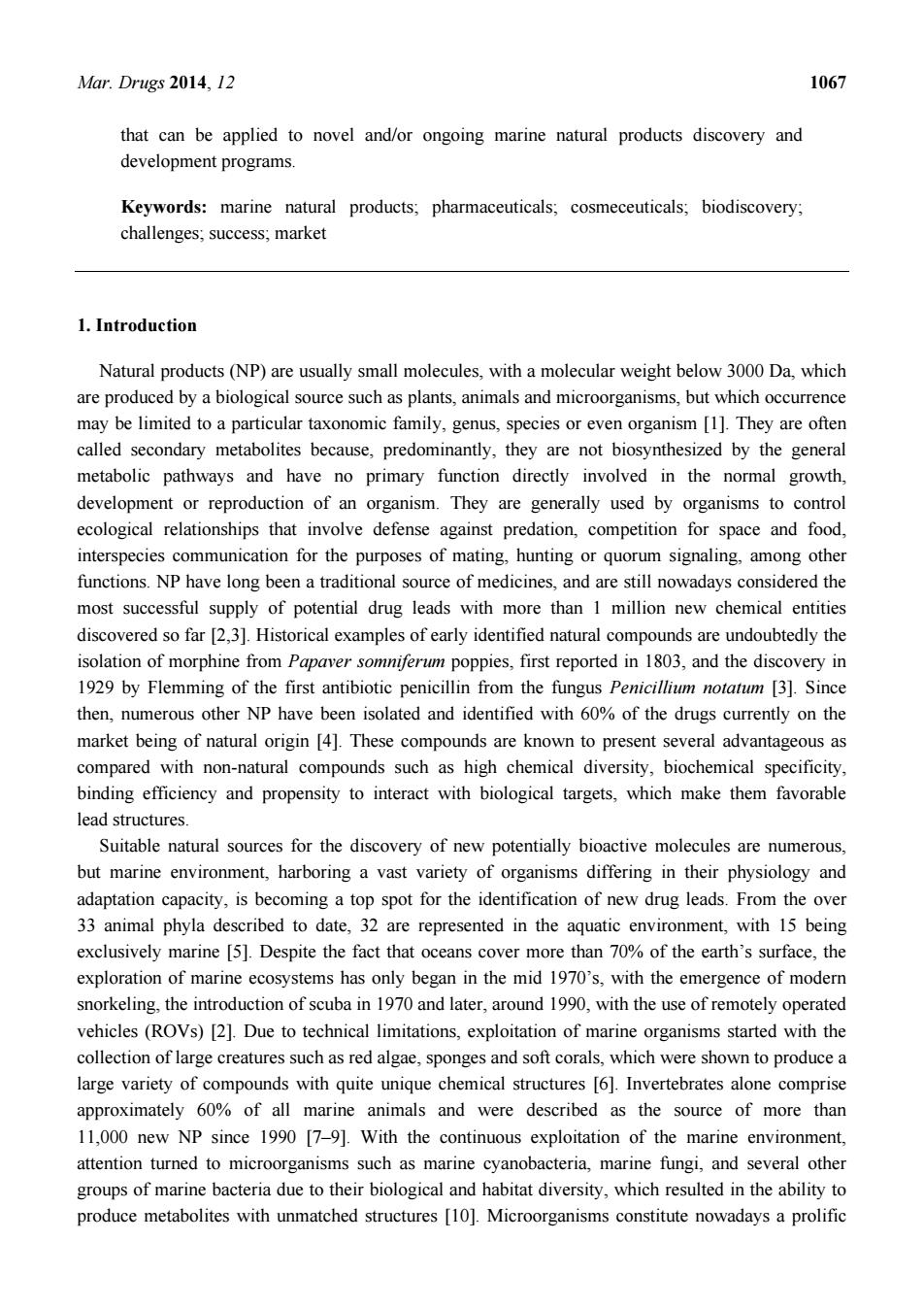正在加载图片...

Mar.Drugs 2014,12 1067 that can be applied to novel and/or ongoing marine natural products discovery and development programs Keywords:marine natural products;pharmaceuticals,cosmeceuticals;biodiscovery; challenges:success;market 1.Introduction Natural products(NP)are usually small molecules,with a molecular weight below 3000 Da,which are produced by a biological source such as plants.animals and microorganisms,but which occurrence may be limited to a particular taxonomic family,genus,species or even organism [1].They are often called secondary metabolites because,predominantly,they are not biosynthesized by the general metabolic pathways and have no primary function directly involved in the normal growth, development or reproduction of an organism.They are generally used by organisms to control ecological relationships that involve defense against predation,competition for space and food, interspecies communication for the purposes of mating.hunting or quorum signaling.among other functions.NP have long been a traditional source of medicines,and are still nowadays considered the most successful supply of potential drug leads with more than 1 million new chemical entities discovered so far [2.3].Historical examples of early identified natural compounds are undoubtedly the isolation of morphine from Papaver somniferum poppies,first reported in 1803,and the discovery in 1929 by Flemming of the first antibiotic penicillin from the fungus Penicillium notatum [3].Since then,numerous other NP have been isolated and identified with60%of the drugs currently on the market being of natural origin [4].These compounds are known to present several advantageous as compared with non-natural compounds such as high chemical diversity,biochemical specificity. binding efficiency and propensity to interact with biological targets,which make them favorable lead structures. Suitable natural sources for the discovery of new potentially bioactive molecules are numerous but marine environment,harboring a vast variety of organisms differing in their physiology and adaptation capacity,is becoming a top spot for the identification of new drug leads.From the over 33 animal phyla described to date,32 are represented in the aquatic environment,with 15 being exclusively marine [5.Despite the fact that oceans cover more than 70%of the earth's surface,the exploration of marine ecosystems has only began in the mid 1970's,with the emergence of modern snorkeling.the introduction of scuba in 1970and later,around 990,with the use of remotely operated vehicles(ROVs)[2].Due to technical limitations,exploitation of marine organisms started with the collection of large creatures such as red algae.sponges and soft corals,which were shown to produce a large variety of compounds with quite unique chemical structures [6].Invertebrates alone comprise approximately 60%of all marine animals and were described as the source of more than 11,000 new NP since 1990 9].With the continuous exploitation of the marine environment. attention turned to microorganisms such as marine cyanobacteria,marine fungi,and several other groups of marine bacteria due to their biological and habitat diversity,which resulted in the ability to produce metabolites with unmatched structures []Microorganisms constitute nowadays a prolificMar. Drugs 2014, 12 1067 that can be applied to novel and/or ongoing marine natural products discovery and development programs. Keywords: marine natural products; pharmaceuticals; cosmeceuticals; biodiscovery; challenges; success; market 1. Introduction Natural products (NP) are usually small molecules, with a molecular weight below 3000 Da, which are produced by a biological source such as plants, animals and microorganisms, but which occurrence may be limited to a particular taxonomic family, genus, species or even organism [1]. They are often called secondary metabolites because, predominantly, they are not biosynthesized by the general metabolic pathways and have no primary function directly involved in the normal growth, development or reproduction of an organism. They are generally used by organisms to control ecological relationships that involve defense against predation, competition for space and food, interspecies communication for the purposes of mating, hunting or quorum signaling, among other functions. NP have long been a traditional source of medicines, and are still nowadays considered the most successful supply of potential drug leads with more than 1 million new chemical entities discovered so far [2,3]. Historical examples of early identified natural compounds are undoubtedly the isolation of morphine from Papaver somniferum poppies, first reported in 1803, and the discovery in 1929 by Flemming of the first antibiotic penicillin from the fungus Penicillium notatum [3]. Since then, numerous other NP have been isolated and identified with 60% of the drugs currently on the market being of natural origin [4]. These compounds are known to present several advantageous as compared with non-natural compounds such as high chemical diversity, biochemical specificity, binding efficiency and propensity to interact with biological targets, which make them favorable lead structures. Suitable natural sources for the discovery of new potentially bioactive molecules are numerous, but marine environment, harboring a vast variety of organisms differing in their physiology and adaptation capacity, is becoming a top spot for the identification of new drug leads. From the over 33 animal phyla described to date, 32 are represented in the aquatic environment, with 15 being exclusively marine [5]. Despite the fact that oceans cover more than 70% of the earth‘s surface, the exploration of marine ecosystems has only began in the mid 1970‘s, with the emergence of modern snorkeling, the introduction of scuba in 1970 and later, around 1990, with the use of remotely operated vehicles (ROVs) [2]. Due to technical limitations, exploitation of marine organisms started with the collection of large creatures such as red algae, sponges and soft corals, which were shown to produce a large variety of compounds with quite unique chemical structures [6]. Invertebrates alone comprise approximately 60% of all marine animals and were described as the source of more than 11,000 new NP since 1990 [7–9]. With the continuous exploitation of the marine environment, attention turned to microorganisms such as marine cyanobacteria, marine fungi, and several other groups of marine bacteria due to their biological and habitat diversity, which resulted in the ability to produce metabolites with unmatched structures [10]. Microorganisms constitute nowadays a prolific